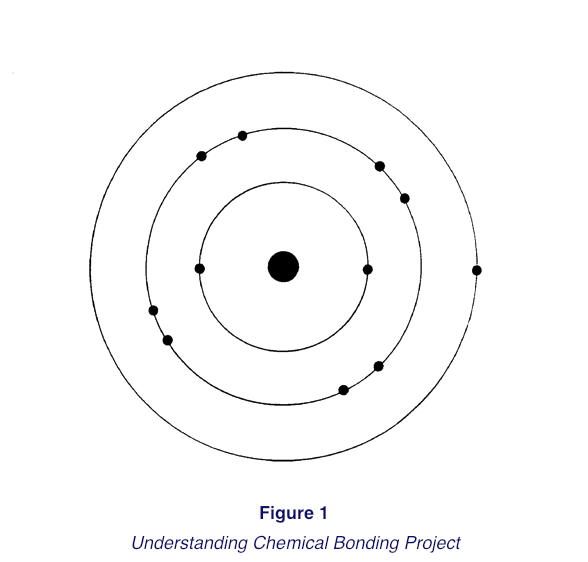
Jagdish was a participant in the Understanding Chemical Bonding project. She was interviewed in the first year of her A level chemistry course, and asked about figure 1 (below).
Is it a stable atom?
(pause, c.4s)
If it was on its own, I mean like, and anything else was like an…infinite distance away, yeah, it would be because there’s nothing to, interact with it, and, I mean even if it wanted to form a lower energy level, a lower, stable, a more stable compound, it would have no means of doing it so yeah, I mean, on its own, yeah.
Tell me what you mean when you say even if it wanted to form, a more stable compound.
Well the way it could form a more stable compound is giving away one of these electrons, right, but this electron, a force has to act on this electron to remove it, and so if there’s, and if there’s nothing else for the electron to go to, or if there’s nothing else to attract that electron, to have a greater effect on that electron than the nucleus has, then it can’t go anywhere, and it’s not gonna (going to) be removed, is it?
I see. So is it fair to say at the moment that atom wants to, form compounds?
Yeah, wants to, yeah.
Jagdish referred to what the atom might 'want' to do, an example of anthropomorphism, yet her explanation was couched in the terms of forces acting. So unlike some student who talk as though the needs or desires of the atom is enough to bring about a change, Jagdish used anthropomorphic language in conjunction with more appropriate scientifically acceptable mechanism. She was probed to see if she would recognise and reject her anthropomorphic formulation:
I mean, are there things it wants to do even more?
(Laughs) Erm. (Pause, c.9s) If you had a, another force in contact with it, and that force could have a significant effect on it, then I think this, atom would want to lose an electron and become an ion, but on its own, no, I think it’s just happy on its own.
So the atom not only had 'wants', but according to Jagdish was able to be "happy". I tested whether she was comfortable with an alternative anthropomorphic phrasing:
Okay, I’m going to try and paraphrase, what we’ve just said…I mean we’ve said that this particular species, although it’s stable in certain situations wants to form compounds. So could I change that and say this species likes to form compounds, would that be true?
(Pause, c.3s)
Yeah.
Erm, this species desires to form compounds?
Yeah.
This species enjoys forming compounds?
(laughs) Yeah.
Erm, this species gets its kicks forming compounds?
(Pause, c.4s)
Erm, yeah.
Yeah? This species after due reflection and consideration, decides it would be a good idea to form compounds.
Mm.
Jagdish did not seem to see any problem with using this kind of language to describe atoms, so I attempted to test out whether she actually considered the atom to have some kind of knowledge of its situation, or was simply using metaphorical language.
You think all those, they’re fair statements, are they? Erm, how does this species know it wants to form compounds?
(Pause, c.4s)
Has it been told, (or) has it worked it out for itself?
At the moment because it’s on its own, I don’t think it knows that it wants to form a compound, but if you had, I think this is sodium right, but if there was another chlorine atom, in, like quite near it, and the distance was small enough to have, for the atoms to have an effect on each other, I think the sodium atom would realise that it could, it could form a more stable configuration by giving one of the electrons to the chlorine and forming a bond, and so it would be at lower energy level.
In what way do you think that realisation comes? …I mean do you think this sees the chloride atom coming?
No I don’t think it sees the chlorine atom coming, I think it feels it.
It feels it coming?
Yeah, ‘cause you’ve got the, you’re going to have some kind of attraction aren’t you? Or repulsion. You’re gonna have some force. The chlorine is going to have some effect on the sodium. The sodium is going to have an effect on the chlorine. So it’s going to feel.
So it has a feeling for it, some sort of awareness?
Yeah.
At the end of this exchange I remains somewhat bemused by Jagdish's comments, which offered a mixture of sound science and a way of describing the situation as though the atom was a sentient being capable of human-like feelings and experiences. In her case the use of anthropomorphic language did not seem to stand in the way of developing an understanding in terms of the forces and attractions as sometimes seemed to be the case with others who talked about atoms using anthropomorphism.

Return to ECLIPSE homepage
List of science topics

Dr Keith S Taber kst24@cam.ac.uk
University of Cambridge Faculty of Education
© Keith S Taber, 2013